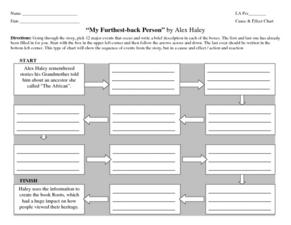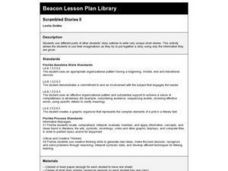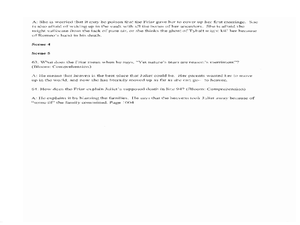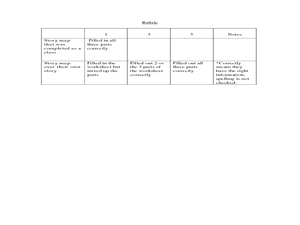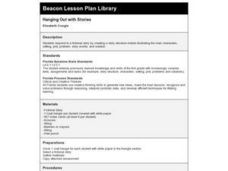Curated OER
Cause & Effect Chart: "My Furthest-Back Person" by Alex Haley
Help your class see the connection between events in Alex Haley's story "My Furthest-Back Person" with this awesome graphic organizer. Individuals write a brief description of 10 major plot events in a series of boxes. The first and last...
Curated OER
After Reading: "Plot the Plot" Activity in the Library Media Class
"Plot the plot" of "The Adventures of the Speckled Band" with your young readers. Take a few days to read Sir Arthur Conan Doyle's short story as a class or in pairs, having learners write down what they consider to be the most important...
Curated OER
The Adventures of Tom Sawyer: Study Help Essay Questions
Use these study questions to test your class on The Adventures of Tom Sawyer by Mark Twain. These mostly higher-level questions have the potential to be test questions, discussion questions, homework questions, or essay questions. The...
Media Smarts
Scripting a Crime Drama
Develop novice script-writers. Small groups sift through a sample script, noting any script-writing conventions to share with the whole class. Using these conventions and plot structures, these groups compose a script for a 10-minute...
Curated OER
Scanning Worksheet-Catullus 58
Your advanced Latin learners mark the metrical pattern in Catullus 58, a poem written by Catullus concerning his love and hatred of Lesbia. Spend time translating the poem so your learners have a complete understanding of the passage.
Curated OER
Volleyball
Students learn the different ways to pass a volleyball while playing the game. In this volleyball lesson plan, students learn how to serve, bump, and pass a volleyball.
Curated OER
Our Town
With the songs "My Hometown" by Bruce Springsteen and "Allentown" by Billy Joel, learners examine external versus internal conflict. When they have finished the first part of the lesson, they create their own poem (or song) about the...
Curated OER
Perceiving Place
Young scholars observe how color creates the mood of a place, and generate sketches and drawings that capture their observations.
Curated OER
Create a Playbill!
Seventh graders explore the various elements found in the advertisement of a dramatic experience. Playbills are created that reflect the plot without revealing the climax of the play. Costumes, set construction, and character description...
Curated OER
Cinderella Folk Tales: Variations in Plot and Setting
Students examine plot and setting of Cinderella, and how it changes as it is translated into different cultures, discuss universal literary elements of the Cinderella story, and write narratives with original settings and plots...
Curated OER
Two Settings
Learners respond to the text Riding Freedom. They will compare and contrast two settings by filling in a graphic organizer. They explore different settings, discuss the reasons why settings change, and draw conclusions using descriptive...
Curated OER
Scrambled Stories II
Review story elements with your class. They will use examples from a story to develop critical-thinking questions. Then they use a graphic organizer to describe the setting, character, and plot of the story, focusing on how they...
Curated OER
Parts of the Plot: Constructing A Plot Diagram
After reading "The King of Mazy May" by Jack London, learners reinforce their literary analysis skills in this SMART board activity. The provided SMART board file allows themto define elements of a short story, and then add it to the...
Curated OER
Boys Will Be Boys...Right?
Through this exercise, high schoolers identify character traits present in Romeo and Juliet. They listen to an excerpt from "The Office of Christian Parents: Showing How Children Are to be Governed" and participate in a Socratic...
Curated OER
Plot and Conflict in W.W. Jacob's "The Monkey's Paw"
Tenth graders analyze the use of literary elements in W.W. Jacob's "The Monkey's Paw." Literary analysis is accomplished by a review of the plot and order of events in the story. Learners work in pairs to match the events from the story...
Curated OER
Interpreting Characters, Setting, Plot, and Theme - The Triangle Shirtwaist Factory Disaster
Examine story development and historical disaster with your class. Learners view a video depicting the incidents surrounding The Triangle Shirtwaist Disaster. They use graphic organizers and the Internet to gather enough information to...
Curated OER
Bucket List Poetry
What is on your pupils' "Bucket Lists" - the list of things they want to do before they die? Their choices of activities for this list could be very revealing, and is a great source of inspiration for a personal poem. The lesson prompts...
National Association of Writers in Education
Character and Situation
Delve into narrative writing that puts choice in the hands of the writers. Kids pick their own characters, emotions, items, and places from a list and tie them together in the exposition. Several questions help guide the writers toward...
Curated OER
Hollywood Magic-The Dream Factory Recreates the Novel
The Great Gatsby, The Jungle and study HRC's Teaching the American Twenties-The Dream Factory are the focus of this lesson, Your students will rewrite a small scene from the novel into a dramatic film scene and then create a modern movie...
Curated OER
Story Stew
Learners identify the elements of a story. For this reading and writing lesson, pupils read the book, Tyrone the Horrible by Hans Wihelm and then identify the characters, setting, and plot of the story.This lesson includes adaptations...
Curated OER
Hanging Out with Stories
Help your class listen and respond to a fictional story by creating a story structure mobile illustrating the main characters, setting, plot, problem, story events, and solution. Using a coat hanger, they will create an artistic element...
Curated OER
Lilly's Purple Plastic Purse: Kevin Henkes
Kevin Henkes has composed a series of books in which Lilly the mouse is a main character. Third graders use illustrations and key details as they compare and contrast the books, Lilly's Purple Plastic Purse and another story staring the...
Curated OER
The "Write" Stuff: Strategies and Conventions for Imaginative Writing
Fifth graders develop and practice the steps involved in imaginative writing. They follow the steps/worksheets included and write imaginative stories of their own.
Curated OER
The Setting
One of the most important elements of a story is the setting; when and where the story takes place. This presentation gives young writers excellent tips on how to create a setting by using visuals, time, description, and interesting...


